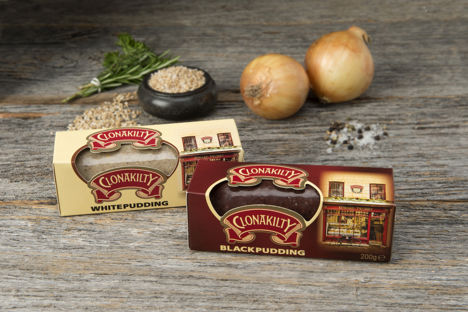
Clonakilty: the story behind Ireland’s favourite black pudding
Clonakilty’s black pudding recipe has been a closely guarded secret for over 100 years, and with good reason – it’s phenomenally popular. We take a look at what makes this Irish black pudding truly special.
Clonakilty: the story behind Ireland’s favourite black pudding
Clonakilty’s black pudding recipe has been a closely guarded secret for over 100 years, and with good reason – it’s phenomenally popular. We take a look at what makes this Irish black pudding truly special.
Black pudding is an unashamed poster child of British and Irish cuisine, and though it still divides opinion thanks to its contents, we’re firmly in favour of the traditional sausage. Yes, the idea of eating something that contains blood is a difficult one for the more squeamish of us, but there’s good reason for it existing; black pudding started as a way of not wasting any part of the animal. In fact, humans have had much the same idea all over Europe, whether that be making boudin noir in France, morcilla in Spain or blutwurst in Germany. Go back far enough and you’ll find records of similar sausages as long ago as Homer’s Odyssey, which dates back well over 2,000 years. If you can look past the list of ingredients, you’ll find something delicious and steeped in history that is worth celebrating.
Fast forward a couple of millennia and you’ll find black pudding alive and well in Britain and Ireland thanks to Clonakilty – a family-run butcher and sausage maker based in the town of the same name in Ireland’s County Cork. Clonakilty’s black pudding itself goes back a long way; in 1880, one Phillip Harrington sold black pudding out of his butcher’s shop in the West Cork village of Clonakilty. His unique black pudding recipe – inherited from a local woman, Johanna O’Brien – was passed down through generations of the Harrington family for a century, until the old butcher’s shop was eventually put up for sale. When Edward Twomey bought the shop in 1976, he inherited the old Clonakilty black pudding recipe with it – a recipe that had been kept secret for 100 years. Thankfully, Edward chose to keep this slice of history alive and the black pudding produced by Clonakilty today is made to exactly the same recipe as it was by Johanna O’Brien and Phillip Harrington over a century ago.
It’s all well and good keeping a recipe alive, but it’s not just history that makes Clonakilty black pudding special. Clonakilty’s black pudding is totally unique, not just because of the secret recipe but also in that it’s made with beef rather than pork, and it has a relatively low blood content compared to other black puddings – just three or four percent. The result is a black pudding with a very crumbly texture and a rich flavour that has a distinct spice and warmth to it.
As with all sausages, the quality of black pudding varies widely depending on the contents. Black pudding generally contains a mixture of meat, blood, oatmeal and onion, often with other spices added for flavour. Poor-quality black pudding will generally have more oatmeal in place of other contents, giving it a mealy texture; not dissimilar to when you buy poor-quality sausages. With Clonakilty, you know that you’re getting a black pudding made to the exact same high standards as it was over a century ago – that means no additives, no preservatives and no artificial flavourings: just great quality ingredients.
There’s no doubt that black pudding is the product that put Clonakilty on the map, but there’s plenty more to look out for. Clonakilty’s Ispíní sausages – made with 100% Irish pork – were once upon a time only available in the Clonakilty butchery, but they became so popular all over Ireland that the company found a way to start selling them in supermarkets. The same is true of Clonakilty’s white pudding – made with Irish pork and given an extra peppery kick. There’s even a new vegetarian pudding to try.
There’s no question that a slice or two of crumbly black pudding – crisped up at the edges – makes a good fry up into a truly great one, but black pudding is a far more versatile ingredient than you might think. The ingredients in Clonakilty black pudding means it crisps up really nicely in a pan or under a hot grill, which makes it ideal for dishes where you want to provide some texture, like this black pudding, scampi and white bean crumble by James Mackenzie. There’s plenty more you can do with it besides – Graham Campbell uses black pudding to stuff a rolled piece of belly pork in his confit belly of pork stuffed with black pudding, for example, and Michael Wignall is a big fan of black pudding puree, which he makes in this venison loin, beetroot and black pudding dish.
For years Clonakilty black pudding was only available in Ireland and people would come from far and wide to buy it, stuffing links of the sausages into their suitcases for the trip home. These days you can buy Clonakilty black pudding in the UK thanks to the likes of Sainsbury’s, Asda, Budgens, Morrisons, Booker, Nisa, Ocado and some independents, with Clonakilty’s Ispíní sausages and white pudding also available, though not as widely. Whether you’re a black pudding connoisseur or you’re looking to broaden your culinary horizons, it makes sense to go with the product that has survived the test of time.



